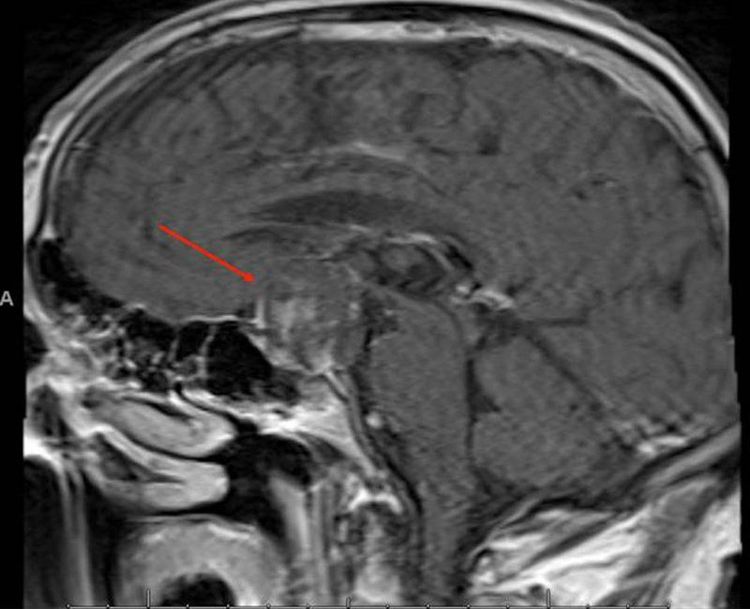This is an automatically translated article.
Pituitary tumors are tumors that arise from the anterior lobe of the pituitary gland. Surgery for pituitary tumors often comes with many serious risks, so your doctor will prioritize choosing the right surgical methods.
1. What is a pituitary tumor?
The pituitary gland is a small, pea-sized gland in the brain located behind the eyes that makes hormones that govern many things including body growth, reproduction, and metabolism. Benign pituitary tumors can grow in size to cause headaches or cause life-threatening nerve or blood vessel problems. The cancerous tumor is removed to prevent the cancer from spreading to other parts of the body. Some hormone-producing pituitary tumors can cause other conditions, such as Cushing's syndrome.The pituitary gland is located near the optic nerve that carries information from the eye to the brain. Tumors of the pituitary gland can cause blurred vision, blurred vision, or double vision. Surgical removal is intended to improve or protect vision and in some cases to correct overproduction of hormones.
Pituitary tumors can be treated by many different methods. The most appropriate option is surgical removal of the tumor. For patients who cannot be operated on, surgical treatment with Gamma Knife. In addition, a CT scan, or an MRI scan, is needed to help the surgeon direct many small radiation beams from different angles to focus on the tumor, and make it shrink and destroy it.

Chẩn đoán bằng hình ảnh giúp bác sĩ đưa ra hướng điều trị thích hợp
2. Pituitary tumor surgery
For pituitary surgery, your doctor will first make an assessment by performing an MRI scan of your pituitary gland. Before surgery, you will need to have blood tests, chest X-ray or electrocardiogram to make sure that you are healthy enough for anesthesia.
There are different ways to perform a surgical resection, depending on the medical condition and the location of the tumor. The surgery is performed under general anesthesia, and takes 1-2 hours to complete.
The pituitary gland can be removed from the body through the nose or open the skull depending on the size and extent of the tumor. In addition, the localized surgery method uses specialized instruments to remove or destroy tissue with high precision through small holes in the skull.
After surgery for pituitary adenoma, the patient will need to lie in the recovery room for about 2 hours before returning to the neurosurgery room. After surgery, you may require hormone replacement therapy. Because the most important hormone cortisol, which is a steroid, helps the body cope with stress. Patients need to be re-examined about 6-8 weeks after surgery. The patient should have a brain MRI, blood tests, and an eye exam to check again.

Khoảng 6-8 tuần sau phẫu thuật bệnh nhân cần tái khám để kiểm tra
3. Complications after pituitary tumor surgery
Possible post-pituitary tumor surgery complications include:
Nosebleed: Complications of pituitary surgery may include nosebleeds, nosebleeds Intracerebral hemorrhage Leakage Cerebrospinal fluid: is a clear liquid that surrounds the brain and spinal cord. Diabetes insipidus: This occurs when hormones that regulate water balance are affected causing excessive thirst and urination. The doctor will prescribe hormone replacement therapy, if the patient is not stable after a few days. Hypopituitarism: When the pituitary gland does not produce hormones as it should, and pituitary function has been compromised by a tumor or other injury during surgery. At this point, your doctor will also prescribe hormone replacement therapy. Other serious but rare complications include:
Carotid artery damage: The carotid artery is the blood vessel on either side of the pituitary gland that supplies blood to the brain. Damage to the carotid artery during surgery can lead to a stroke or even death. This complication has an extremely low rate of less than 1%. Vision impairment: Surgery may be needed to remove blood clots that are pressing on the optic nerve. In summary, pituitary surgery aims to remove the tumor and try to preserve as much of the pituitary gland as possible. Surgery for pituitary adenomas is only an option when other methods of treatment are not effective. Surgery for a pituitary tumor carries many risks, so your doctor will consider the right treatments.
Vinmec International General Hospital is one of the hospitals that not only ensures professional quality with a team of leading medical doctors, modern equipment and technology, but also stands out for its examination and consultation services. comprehensive and professional medical consultation and treatment; civilized, polite, safe and sterile medical examination and treatment space.
Customers can directly go to Vinmec Health system nationwide to visit or contact the hotline here for support.
In April & May 2021, when there is a need for examination and treatment of pituitary tumor at Vinmec Central Park International General Hospital, customers will enjoy double incentives:
- Free specialist examination
- 50% discount for customers with post-examination treatment indications. The program is limited to the corresponding technique of each hospital and to customers who perform this treatment technique for the first time at Vinmec.













